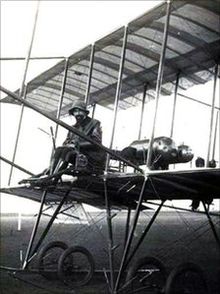Giulio Gavotti: Difference between revisions
Corrects ISBN |
OccultZone (talk | contribs) m clean up, common fixes using AWB |
||
| Line 3: | Line 3: | ||
==Aerial bombardment== |
==Aerial bombardment== |
||
On the 1 November |
On the 1 November 1911, he flew his early model [[Etrich Taube]] monoplane against [[Military of the Ottoman Empire|Ottoman military]] in [[Libya]].{{r|Flight100_59}}{{r|i}}{{r|c}} He took four grenades ("''Cipolli''"{{r|c}}) to a leather pouch, each of a size of grapefruit and weighing{{r|i}} approximately four pounds. Flying at an altitude of 600 feet, Gavotti screwed in the detonators and tossed each missile over the side{{r|Flight100_59}} - three onto the [[Tagiura]] ([[Jagiura]]) [[oasis]], and one more onto [[military camp]] at [[Ain Zara]].{{r|i}}{{r|c}} Gavotti’s scheme injured no one.<ref>http://axisofevelknievel.blogspot.com/2007_11_01_archive.html</ref> |
||
The oldest known preserved Etrich Taube, in Vienna, Austria, is possibly a near-twin to the aircraft Gavotti flew in 1911, as both are said to have been powered with inline-four cylinder liquid-cooled powerplants. |
The oldest known preserved Etrich Taube, in Vienna, Austria, is possibly a near-twin to the aircraft Gavotti flew in 1911, as both are said to have been powered with inline-four cylinder liquid-cooled powerplants. |
||
After this and further missions, the [[Ottoman Empire]] issued a protest. The dropping of bombs from [[balloon]]s had been outlawed by the [[Hague Conventions of 1899 and 1907|Hague Convention of 1899]], but Italy argued that this ban did not extend to aircraft.<ref name="Flight100_59"/> |
After this and further missions, the [[Ottoman Empire]] issued a protest. The dropping of bombs from [[balloon]]s had been outlawed by the [[Hague Conventions of 1899 and 1907|Hague Convention of 1899]], but Italy argued that this ban did not extend to aircraft.<ref name="Flight100_59"/> |
||
==Night mission== |
==Night mission== |
||
Gavotti performed the historically first night mission of a heavier-than-air aircraft. It took place as part of the same campaign in Libya on 4 March |
Gavotti performed the historically first night mission of a heavier-than-air aircraft. It took place as part of the same campaign in Libya on 4 March 1912.<ref>{{cite news | url=http://www.bbc.co.uk/news/world-europe-13294524 | title=Libya 1911: How an Italian pilot began the air war era | work=BBC News Website | date=May 10, 2011 | accessdate=May 10, 2011}}</ref> |
||
==See also== |
==See also== |
||
| Line 23: | Line 23: | ||
<ref name="Flight100_59">{{cite book |last=Grant |first=R.G. |title=Flight - 100 Years of Aviation |pages=59 |publisher=Dorling-Kindersley Limited |year=2004 |isbn=1-4053-0575-4 }}</ref> |
<ref name="Flight100_59">{{cite book |last=Grant |first=R.G. |title=Flight - 100 Years of Aviation |pages=59 |publisher=Dorling-Kindersley Limited |year=2004 |isbn=1-4053-0575-4 }}</ref> |
||
<ref name="i">''The influence of air power upon history'' by Walter J. Boyne, p.38 |
<ref name="i">[http://books.google.com/books?id=X-YiU-PJ0ogC&pg=PA38 ''The influence of air power upon history'' by Walter J. Boyne, p.38]</ref> |
||
<ref name=c>{{cite book|last=Chant|first=Christopher|title=Austro-Hungarian aces of World War 1|year=2002|publisher=Osprey|location=Oxford|isbn=1-84176-376-4|pages=38–39|url=http://books.google.com/books?id=YmwNv_9_cL4C&lpg=PA39&dq=Tripoli%20first%20bombed%201914&pg=PA39#v=onepage&q&f=false}}</ref> |
<ref name=c>{{cite book|last=Chant|first=Christopher|title=Austro-Hungarian aces of World War 1|year=2002|publisher=Osprey|location=Oxford|isbn=1-84176-376-4|pages=38–39|url=http://books.google.com/books?id=YmwNv_9_cL4C&lpg=PA39&dq=Tripoli%20first%20bombed%201914&pg=PA39#v=onepage&q&f=false}}</ref> |
||
}} |
}} |
||
| Line 42: | Line 42: | ||
[[Category:1939 deaths]] |
[[Category:1939 deaths]] |
||
[[Category:Italian Air Force personnel]] |
[[Category:Italian Air Force personnel]] |
||
{{Italy-mil-bio-stub}} |
{{Italy-mil-bio-stub}} |
||
Revision as of 18:03, 8 May 2014

Giulio Gavotti (17 October 1882 - 6 October 1939) was an Italian lieutenant and pilot, who fought in the Italo-Turkish War. He set two firsts in the history of aerial warfare of heavier-than-air flyers: he was the first man to make an aerial bombardment, as well as the first to perform a night mission.
Aerial bombardment
On the 1 November 1911, he flew his early model Etrich Taube monoplane against Ottoman military in Libya.[1][2][3] He took four grenades ("Cipolli"[3]) to a leather pouch, each of a size of grapefruit and weighing[2] approximately four pounds. Flying at an altitude of 600 feet, Gavotti screwed in the detonators and tossed each missile over the side[1] - three onto the Tagiura (Jagiura) oasis, and one more onto military camp at Ain Zara.[2][3] Gavotti’s scheme injured no one.[4]
The oldest known preserved Etrich Taube, in Vienna, Austria, is possibly a near-twin to the aircraft Gavotti flew in 1911, as both are said to have been powered with inline-four cylinder liquid-cooled powerplants.
After this and further missions, the Ottoman Empire issued a protest. The dropping of bombs from balloons had been outlawed by the Hague Convention of 1899, but Italy argued that this ban did not extend to aircraft.[1]
Night mission
Gavotti performed the historically first night mission of a heavier-than-air aircraft. It took place as part of the same campaign in Libya on 4 March 1912.[5]
See also
Notes
- ^ a b c d Grant, R.G. (2004). Flight - 100 Years of Aviation. Dorling-Kindersley Limited. p. 59. ISBN 1-4053-0575-4.
- ^ a b c d The influence of air power upon history by Walter J. Boyne, p.38
- ^ a b c d Chant, Christopher (2002). Austro-Hungarian aces of World War 1. Oxford: Osprey. pp. 38–39. ISBN 1-84176-376-4.
- ^ http://axisofevelknievel.blogspot.com/2007_11_01_archive.html
- ^ "Libya 1911: How an Italian pilot began the air war era". BBC News Website. May 10, 2011. Retrieved May 10, 2011.
